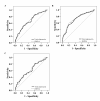Total and high molecular weight adiponectin have similar utility for the identification of insulin resistance
- PMID: 20573249
- PMCID: PMC2902434
- DOI: 10.1186/1475-2840-9-26
Total and high molecular weight adiponectin have similar utility for the identification of insulin resistance
Abstract
Background: Insulin resistance (IR) and related metabolic disturbances are characterized by low levels of adiponectin. High molecular weight adiponectin (HMWA) is considered the active form of adiponectin and a better marker of IR than total adiponectin. The objective of this study is to compare the utility of total adiponectin, HMWA and the HMWA/total adiponectin index (SA index) for the identification of IR and related metabolic conditions.
Methods: A cross-sectional analysis was performed in a group of ambulatory subjects, aged 20 to 70 years, in Mexico City. Areas under the receiver operator characteristic (ROC) curve for total, HMWA and the SA index were plotted for the identification of metabolic disturbances. Sensitivity and specificity, positive and negative predictive values, and accuracy for the identification of IR were calculated.
Results: The study included 101 men and 168 women. The areas under the ROC curve for total and HMWA for the identification of IR (0.664 vs. 0.669, P = 0.74), obesity (0.592 vs. 0.610, P = 0.32), hypertriglyceridemia (0.661 vs. 0.671, P = 0.50) and hypoalphalipoproteinemia (0.624 vs. 0.633, P = 0.58) were similar. A total adiponectin level of 8.03 mug/ml was associated with a sensitivity of 57.6%, a specificity of 65.9%, a positive predictive value of 50.0%, a negative predictive value of 72.4%, and an accuracy of 62.7% for the diagnosis of IR. The corresponding figures for a HMWA value of 4.25 mug/dl were 59.6%, 67.1%, 51.8%, 73.7% and 64.2%.The area under the ROC curve of the SA index for the identification of IR was 0.622 [95% CI 0.554-0.691], obesity 0.613 [95% CI 0.536-0.689], hypertriglyceridemia 0.616 [95% CI 0.549-0.683], and hypoalphalipoproteinemia 0.606 [95% CI 0.535-0.677].
Conclusions: Total adiponectin, HMWA and the SA index had similar utility for the identification of IR and metabolic disturbances.
Figures


References
-
- Nakano Y, Tobe T, Choi-Miura NH, Mazda T, Tomita M. Isolation and characterization of GBP28, a novel gelatin-binding protein purified from human plasma. J Biochem. 1996;120:803–812. - PubMed
-
- Yamauchi T, Kamon J, Waki H, Terauchi Y, Kubota N, Hara K, Mori Y, Ide T, Murakami K, Tsuboyama-Kasaoka N, Ezaki O, Akanuma Y, Gavrilova O, Vinson C, Reitman ML, Kagechika H, Shudo K, Yoda M, Nakano Y, Tobe K, Nagai R, Kimura S, Tomita M, Froguel P, Kadowaki T. The fat-derived hormone adiponectin reverses insulin resistance associated with both lipoatrophy and obesity. Nat Med. 2001;7:941–946. doi: 10.1038/90984. - DOI - PubMed
-
- Hara K, Horikoshi M, Yamauchi T, Yago H, Miyazaki O, Ebinuma H, Imai Y, Nagai R, Kadowaki T. Measurement of the high-molecular weight form of adiponectin in plasma is useful for the prediction of insulin resistance and metabolic syndrome. Diabetes Care. 2006;29:1357–1362. doi: 10.2337/dc05-1801. - DOI - PubMed
Publication types
MeSH terms
Substances
LinkOut - more resources
Full Text Sources
Medical
Miscellaneous

